---------------------------------------------
CHAPTER
- 1 -
The Pilot of the Pinta
CHAPTER
- 1 -
The Pilot of the Pinta
I had resolved on a voyage around the world,
and as the wind on the morning of April 24,
1895, was fair, at noon I weighed anchor, set
sail, and filled away from Boston, where the
Spray had been moored snugly all winter. The
twelve o'clock whistles were blowing just as the
sloop shot ahead under full sail. A short board
was made up the harbor on the port tack, then
coming about she stood to seaward, with her
boom well off to port, and swung past the fer-
ries with lively heels. A photographer on the
outer pier at East Boston got a picture of her
as she swept by, her fag at the peak throwing
its folds clear. A thrilling pulse beat high in me.
My step was light on deck in the crisp air. I felt
there could be no turning back, and that I was
engaging in an adventure the meaning of which
I thoroughly understood.
SAILING ALONE AROUND THE WORLD,
BY JOSHUA SLOCUM
THUS BEGAN THE FIRST AND MOST FAMOUS SOLO CIRCUM-
navigation in maritime history, a voyage of adventure and escape, and
a feat of seamanship that remains unsurpassed in all the annals of
men who go down to the sea in ships.
The author of these charming lines, and the skipper of the 37-foot
~ 3 ~
Spray(1) on that crisp April morning, was Captain Joshua Slocum, and
he had just marked his fifty-first birthday. Behind him were a 20-year
career as master of some of the finest merchant ships afloat; a
supremely happy life with his sea wife, Virginia, which produced four
surviving children all born at sea or in exotic ports; and high adven-
ture most of which crumbled around him in ruins, tragedy, and
personal despair in middle age, the most critical time in any man's
life.
The Spray was all that he had left, and it was a century-old
oysterman that had been hauled out on the beach unused for many
years. Given to Slocum by a friend, Captain Eben Pierce, as a joke,
he set about characteristically and rebuilt her from the keel up, at a
cost of $553.62 and thirteen months' labor.
Slocum's description of his departure from Boston on his solo
circumnavigation, written several years later, did not fail to recapture
his exhilaration and exuberance of once again walking the slanting
deck of his own sailing ship, escaping to the wonderful sea that had
charmed him since his childhood.
Left behind were agonizing memories of Virginia, who had died
suddenly in Buenos Aires aboard their beautiful bark Aquidneck
some years before, the confusion and hopelessness of an old sailor
cast up on the beach, a second wife whom he regarded as little more
than a a baby sitter for his children, and the great social and economic
disorders that were changing his world as he knew it, and to which he
was unable to adapt.
He had $1.80 in cash, agreements with several newspapers to file
stories along the way at space rates, and a number of copies of a book
he had written previously and printed at his own expense, The
Voyage of the Liberdade.(2) He did not, however, have any timetable,
nor even any clear-cut idea of what route he would take. His first
landfall was Gloucester, only twenty miles away. There he spent two
weeks enjoying a visit, and acquiring a dinghy by the simple expedi-
ent of sawing a Cape dory in half and boarding up the open end so
that it would fit athwartships on the deck between the trunk cabins.
Leaving Gloucester, he sailed east instead of south as everyone
expected including his irritated editors. He sailed through the tide
race in the Bay of Fundy and to Brier Island, where he had been
born and raised. A month passed, then another, and he was still in
Nova Scotia. Finally, on July 2, his gamming with relatives and old
boyhood friends done, and the Spray made ready for sea with stores
of fresh butter, potatoes, water in casks, and a dollar-and-a-half tin
~ 4 ~
clock with broken hands that he had acquired as a chronometer,3 he
let go his grasp on the North American continent. Eighteen days later,
after a magnificent sail, he reached the Azores.
After a short visit there, Slocum left for Gibraltar with a supply of
fresh white cheese and ripe plums. Gorging on these as he sailed into
a storm area, he was soon immobilized by cramps and passed out on
the floor of the cabin. It was during this wild night, as his ship raced
through the storm unattended, that Slocum recalled the pilot of the
Pinta coming aboard to assist him in the crisis.(4)
At Gibraltar, Slocum was welcomed heartily by the British Navy,
wined and dined, and even taken on an excursion to North Africa
aboard a newfangled motor torpedo boat at a speed of 20 knots.
Naval officers warned him not to attempt an east-to-west passage
through the Mediterranean because of pirates, so he then altered his
plans to follow the trade route south through the Atlantic and
around Cape Horn to the Pacific. Forty days later, after a few hours
of thrilling suspense when a pirate felucca put out from Africa to
intercept him, he arrived at Pernambuco (Recife), on the bulge of
Brazil. Here he tried to collect some money due him from the Brazil-
ian government, and failing this, continued on along the coast to Rio
de Janeiro, some 1,200 miles in 12 days, stopping for mail, selling
books, and renewing old acquaintances among seafaring people.
Leaving Rio, Slocum ran aground just south of the Brazilian
border, and after refloating he continued on to Montevideo, where
he met an old friend and Rio de la Plata pilot, Captain Howard of
Cape Cod. Together they sailed across to Buenos Aires, where
Virginia had been buried in English Cemetery.(5) Then, overcome by
his old grief, Slocum departed suddenly for the challenge ahead. On
the way south, he encountered a monster wave, a frighteningly
common occurrence in the southern latitudes, but Spray came
through the ordeal easily, which gave Slocum the final confidence he
needed that his ship would take him anywhere.(6)
In early February, he rounded Cape Virgins, deciding to make the
passage through the Strait of Magellan. It was the wrong time of the
year to attempt the outside passage around the Horn. At the small
frontier city of Punta Arenas, Slocum stopped for rest and recreation,
and here was warned about the murderous savages who preyed on
ships and stranded seamen in the Tierra del Fuego labyrinth and
especially one Black Pedro, the most wicked, murderous, and cunning
of them all. He was given a box of carpet tacks and told how to use
them to prevent being surprised at night while at anchor. For the
~ 5 ~
next two months he battled the fierce williwaws and tidal races of the
Strait, outguessed and outfought fleets of fire canoes, and even sur-
vived an encounter with Black Pedro himself. On his first attempt to
break out the western entrance, Slocum was caught in a storm and
swept southward around the Horn for days, during which he decided
he would change his plans and sail east-about after all.(7) Then, spot-
ting an opportunity, he turned in through the frightening Milky Way
reefs that Charles Darwin had first described in awe, and safely made
his way back into the Strait again.
On his second attempt, on April 13, Spray succeeded in making an
offing, and Slocum joyously steered northwest for the Robinson
Crusoe island of San Fernandez. Here he was welcomed by the
islanders, and for nearly a month enjoyed their hospitality, especially
that of the children, whom he liked to be around.
Sailing on May 5, 1896, he ran down the trades for seventy-three
days in one of his most enjoyable passages, most of which was spent
in the cabin reading, with no one at the wheel. Passing up the
Marquesas, a popular stop for all sailing ships, he made his landfall at
Samoa. Here he paid his respects to Fanny Stevenson, widow of his
favorite author, and spent the rest of the summer. In October, after a
boisterous passage, he arrived in Newcastle, New South Wales, now a
year and a half out of Boston.
Slocum had friends and relatives here, for this was where he had
met and married Virginia and carried her off on his ship as a young
bride. His voyage had now become famous all over the world, and
much publicity was generated by his appearance and stay in Australia.
He made the most of it. Then, restless again, he departed. At first, he
planned to sail south of Australia, around Cape Leeuwin, but because
of the season of the year he decided to cross over to Tasmania in-
stead. At Hobart, he beached the Spray for maintenance, and gave
lectures to raise funds. In May, he was sailing inside the Great Barrier
Reef the other way around Australia, through Torres Strait. By June,
he had left the Coral Sea and was en route across the Indian Ocean
to the tiny atoll islands of Keeling-Cocos. It was on this leg that he
made his classic passage down the trades from Christmas Island
2,700 miles in 23 days with the helm untouched to arrive at this
tiny flyspeck in the center of the entrance channel.
Slocum records a delightful stay on the islands, which were owned
by the Clunies-Ross family,(8) but it was the children whom he most
enjoyed, especially a ten-year-old named Ophelia, who wrote a poem
~ 6 ~
in his logbook about the great kpeting (giant crab) that kept ships
there by holding onto the keel.
Admiral Fitzroy of the Beagle had written of these tiny isolated
islands "where crabs eat coconuts, fish eat coral, dogs catch fish, men
ride on turtles, and shells are dangerous mantraps."
Slocum refitted the Spray, then threw overboard his ballast and
loaded the hold with giant tridacna shells which he planned to sell or
trade later in the voyage.
On August 22, the kpeting let go his keel and Slocum departed for
Rodriguez. His stay there was also pleasant, as a guest of the gover-
nor, but after only eight days he departed for Mauritius, loaded down
again with fresh fruits and vegetables.
It was still winter off the great Cape of Good Hope, so he tarried
on this pleasant island until October 26, and then set sail via Cape St.
Mary on the southern tip of Madagascar, weathering the stormy
Mozambique Channel, and arriving in Durban, South Africa, on
November 17. News of his arrival was already in print and on the
street in the morning newspaper before he arrived, and a copy was
handed to him by port officials. Port Natal was then, as now, a
favorite stop for world voyagers because of the hospitality of the local
yachtsmen, and because it afforded a safe haven in which to wait for
favorable weather to double the Cape.
Slocum was again wined and dined, introduced to all the impor-
tant people, sought out by President Paul Kruger and the famed
explorer, Stanley, of Stanley and Livingstone legend, colonels and
colonels' ladies. He took trips into the back country, visited schools
where he had the pleasure of meeting many bright children, and like
almost all other visitors clucked sadly over the rigid social and
economic barriers of the South African society.
On December 14, Slocum reluctantly departed, managed the
frightful seas off the great bight of the continent, rounded Cape
Agulhas (the actual southernmost tip of Africa), Cape of Good
Hope, Table Mountain, and came to anchor off the city of Cape
Town. Again he settled down for weeks of socializing with admirals,
colonels, high-placed politicians, local yachtsmen, and hospitable
citizens of all rank. As many other voyagers, he was tempted to end
his journey and settle down in this pleasant and dynamic country, but
on March 26, 1898, he was on his way again with a nice light morning
breeze giving him an offing for the next leg to the island of St.
Helena, with the Spray running sprightly under a single-reefed main-
~ 7 ~
sail, whole jib, and flying jib, leaping along among the marching white
sea horses, with porpoises playing off the bow. On April 11, he caught
sight of the island where Napoleon spent his last days, opened a
locker, and with a bottle of port wine toasted the health of his
invisible helmsman, the pilot of the Pinta.
As usual, Slocum was given the freedom of the port and was hosted
by the governor. He paused to visit with the local families, and was
given a goat by the American consul there, a Mr. R. A. Clark.(9)
Slocum, who did not like pets, had nothing but trouble with his goat
and managed to put it ashore in Ascension, but not until it had eaten
his only chart of his next landfall, the West Indies. He had the Spray
fumigated here and the ship's papers put in order by the British
officer in charge of the "Stone Frigate."
On May 8, 1898, the Spray crossed her outbound track, thus com-
pleting a technical circumnavigation to a point on his track of
October 2, 1895. Slocum sailed south of Fernando de Noronha,
passing it at night. On May 10, there was a change in the condition
of the sea, and to Slocum, an old hand in these waters, this meant
that he was off St. Roque and was in the north-moving current. He
had been in the trade winds for some time, and now also had the
benefit of a forty-mile-a-day current.
Somewhere in this region, he encountered the U.S.S. Oregon. The
battleship hoisted the signal "C B T," meaning, "Are there any men-
of-war about?"
Slocum replied in the negative and then added his own signal:
"Let us travel together for mutual protection."
Thus, Slocum learned that the United States was at war with
Spain. On May 18, he saw the north star or Polaris for the first time
in nearly three years, and he was logging better than 140 miles a day.
His first stop was at Grenada, to which he carried letters from
Mauritius, and he came into the roads off the island on May 22. On
June 1, he arrived at St. John, Antigua, where he was welcomed by
the governor and his lady, and was invited to lecture on his exploits.
On June 4, he cleared with the United States consulate, and his yacht
license was returned to him for the last time, with a personal note
written on it by the consul.(10)
On June 8, the Spray passed under the sun and bounded joyously
for home waters. For three days, Slocum was becalmed in the Sar-
gasso Sea, then entering the Gulf Stream, he encountered a fierce
gale which broke some of the weary rigging. Fighting his way through
squalls and cobble seas northward to Fire Island, there he was caught
~ 8 ~
in the tornado of June 25, which had wrecked buildings a few min-
utes earlier in New York City.
With a sea anchor out, he weathered the storm, and when it was
over and the Spray was safe once more, Slocum recorded that he
never saw the pilot of the Pinta again.
The Spray rounded Montauk Point, carried Point Judith abeam at
dark, and fetched in at Beavertail. Sailing on, Slocum hugged the
shore going into Newport Harbor, which was mined, and at last,
reached safe anchorage at one A.M., June 27, 1898, after a voyage of
46,000 miles and an absence of three years and two months a
voyage that carried him into immortality.
Later, the Spray waltzed cockily around the coast and up the
Acushnet River to Fairhaven, where Slocum secured to the same
stake driven into the bank to tether her when she was launched.
"I could bring her no nearer home," Slocum wrote.
The world was now ready for Captain Joshua Slocum, and like a
true Yankee shipmaster, he was quick to take full measure of it.
When Slocum had departed on his voyage three years before, one
of the last well-wishers to see him off was the girl to whom he
dedicated his book, twenty-four-year-old Mabel Wagnalls, daughter
of an old friend, Adam Wagnalls, the publisher. First to come aboard
to write a welcome in his logbook was Miss Wagnalls "the one who
said the Spray would come back."
Slocum's original motive for making the voyage around was, osten-
sibly at least, to write stories about it for publication, including
possibly a book. Although his initial arrangements to file stories to
newspapers had collapsed along the way because of the time element
and lack of editorial interest, he still wanted very much to write up
his accounts in the same vein as the popular travel books of Mark
Twain and Robert Louis Stevenson. So, while still at the Keeling-
Cocos Islands, he wrote to Joseph Benson Gilder, editor of The
Critic, the literary magazine of the day, and younger brother of
Richard Watson Gilder, the great editor of Century Magazine.
Young Gilder had previously written a favorable review of Slocum's
book, The Voyage of the Liberdade, and can now be considered the
first to "discover" Slocum's literary potential. The letter, written
seven years afterward while the Spray was tied to a palm tree on
remote Keeling-Cocos, can be considered the genesis of Sailing Alone
Around the World, one of the all-time great maritime classics, which
Van Wyck Brooks described in The Confident Years as the "nautical
equivalent of Thoreau's account of his life in the hut at Walden."
~ 9 ~
"Do you think," Slocum concluded in his letter to Gilder, "our
people will care for a story of the voyage around?"
Now, immediately after arriving home, Slocum received a telegram
requesting his story from Richard Watson Gilder. It was the begin-
ning of Slocum's happiest association since the death of Virginia, and
the culmination of a lifetime ambition to be an author. At first,
however, because he was still restless, it was hard to settle down to
the actual chore of putting together his story. The Spanish-American
War was still occupying the front pages and Slocum thought of volun-
teering to skipper a gunboat in the Philippines, still remembering the
perfidy of petty Spanish officialdom from the days when he was a
shipmaster and shipbuilder in the China trade. He talked of fitting
out a college ship to accommodate three hundred student-passengers
on a voyage around the world, during which they could learn seaman--
ship as well as study liberal arts and engineering courses.
At last, he got down to work on the series, first while living with
his wife, Hettie, whom he had rejoined, and later in the winter
aboard the Spray tied up at the Erie Basin Drydocks in Brooklyn. He
delivered the manuscript in the summer of 1899 and immediately
celebrated with a cruise in New England waters, correcting galley
proofs& as he sailed. The story was published in monthly installments,
from September 1899 through March 1900. The book was published
by the Century Company on March 24, 1900, illustrated with pen
drawings by Thomas Fogarty and George Varian. A second edition
was published the same year in England. There were sixteen reprint-
ings by Century through 1941, three printings by Blue Ribbon Books
in the 1930s, and additional printings by Sheridan House, Inc., and
Grosset & Dunlap, Inc. Charles Scribner's Sons brought out an
abridged edition for schools in 1903. French, Polish, German, and
Dutch editions appeared over the years. The book entered the public
domain in 1956, and since then numerous reprints have appeared in
various forms with seemingly a steady increase in reader interest
rather than a decline.
Sailing Alone Around the World was an immediate critical and
financial success. With the proceeds of its sales, plus Slocum's lucra-
tive lecture and lantern slide appearances, he was able to pay off his
debts and buy a farm for Hettie on Martha's Vineyard. In addition,
he was able to capitalize on his new fame by selling copies left over
from his previous efforts, The Voyage of the Liberdade
and The Voyage of the Destroyer.
He wrote and published pamphlets to advertise his wares such as
~ 10 ~
the Sloop Spray Souvenir, which he sold at the Pan American Exposi-
tion at Buffalo, where he exhibited the globe-circling Spray, charged
admission, and sold books and souvenirs.
He planned also to exhibit an expedition to Iceland and the Arctic
at the Universal Exposition in Paris. He toyed with underwater
experiments and with the newfangled flying machine; he became a
frequent visitor and confidant of President Teddy Roosevelt and
often took the President's son sailing on the Spray; he made short
cruises in New England waters, and in 1905 made the first of several
annual winter sojourns to Jamaica, Grand Cayman, and other ports
in the West Indies.
Returning from one cruise, and while on a lecture tour in New
Jersey, he was arrested on a charge of molesting a twelve-year-old girl.
After spending two months in jail, he then pleaded nolo contendere
to a reduced charge and was released by the judge after a lecture on
morals. It is unlikely that Slocum was actually guilty of molesting the
child; more likely, his flinty pride refused to take the charge seriously.
His biographer, Walter Magnes Teller, draws a perceptive parallel in
Melville's Mardi, "the heart-loneliness which overtakes most seamen
as they grow aged, impelling them to fasten on some chance object of
regard.(11)
In any case, Slocum did not let it trouble him. He went from the
jail in New Jersey to Sagamore Hill, where he was welcomed cordially
by President Roosevelt and took young Archibald Roosevelt for a
week's cruise.
Each winter thereafter, Slocum sailed south to the Caribbean,
increasingly restless and unable to settle down in Martha's Vineyard
with Hettie. In 1909, at age sixty-five, he set off on another expedi-
tion, this time to explore the Orinoco up to the Rio Negro, then sail
down the Amazon to the Atlantic Ocean. He was never seen nor heard
from again, and was declared legally dead as of November 14, 1909.
There have been many theories about his disappearance including
suicide, fire at sea, storms, and even disintegration of the aged Spray.
The most logical is the one suggested by Slocum's eldest son, Victor,
also an experienced sea captain. Victor believed that his father was
run down at night in the crowded ship lanes off Cape Hatteras.
Collision at sea between large, fast vessels and small craft, particularly
in such congested areas, remains a major hazard today.(l2)
In spite of his simplistic, dead-center Yankee manner and appear-
ance, Joshua Slocum was a complex man, a personality of paradoxes.
Born February 20, 1844, on Brier Island, Nova Scotia, he was de-
~ 11 ~
scended from a seafaring English family that had settled in New
England in the early eighteenth century, but removed to Nova Scotia
during the War of Independence. Later, the family drifted back to
Massachusetts and Joshua became a naturalized American.
His father was a large, muscular, somewhat frustrated and embit-
tered man, stern and unrelenting in views, a church deacon, farmer,
and bootmaker. His mother was a daughter of a lighthouse keeper on
Brier Island, small, delicate, gentle, and fine-featured. Joshua took
after her in physical appearance and appreciation of finer things and
after his father in grit, determination, and aggressiveness.(13)
His mother was young Joshua's whole world, and as long as she
lived, he endured his father's brutality and the harsh life. When she
died at forty-six, he left home for good to follow the sea. His first
voyage was at sixteen on a British ship. Quick, intelligent, loyal, and
handy with his fists, he learned fast and rose quickly, obtaining his
first command as captain of an American coastal schooner out of San
Francisco when he was only twenty-five. During this period, he also
engaged in various adventures on the northwest coast, including
commercial fishing, trapping, and boat building. His son Victor
credited his father with the design of the famed Columbia River
gillnet boats, although this is unlikely.
His second command was the bark Washington, which sailed from
San Francisco to Sydney with a mixed cargo. There he met Virginia
Walker, daughter of an American immigrant, and after a two-week
courtship, they were married and spent their honeymoon on a voyage
to Cook Inlet in Alaska to take on a cargo of salmon. Virginia was a
perfect soul mate, witty, intelligent, cultured, yet courageous and
adventurous and a dead shot with a pistol, which came in handy
during several attempted mutinies in later years.
Though the Washington was wrecked in Alaskan waters, most of
the cargo was saved by the efforts of her captain, and the owners
responded by giving Slocum the command of another ship, the bark
Constitution. Victor was born aboard this vessel in 1872. The next
residence of the little family was aboard the square-rigger B. Aymar.
Then followed a shipbuilding period in the Philippines in which he
acquired a beautiful little 45-ton schooner Pato, Spanish for "duck."
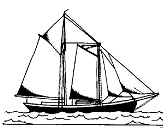 The Pato was first employed in salvage operations, and then, with his
family that now included two boys and a girl, Slocum picked up gear,
dories, and a crew in Hong Kong and sailed through the Sea of Japan
to waters off Kamchatka on a cod-fishing venture. Thousands of miles
from the nearest medical help, Virginia gave birth to twins. They
~ 12 ~
died four days later, and the following day Virginia joined the rest
of the crew at the rail, bringing aboard a cargo of cod which was
salted down and taken to Portland, Oregon, and peddled from door
to door. With the proceeds of this operation, during which the
family lived ashore on the east bank of the Willamette River, and the
The Pato was first employed in salvage operations, and then, with his
family that now included two boys and a girl, Slocum picked up gear,
dories, and a crew in Hong Kong and sailed through the Sea of Japan
to waters off Kamchatka on a cod-fishing venture. Thousands of miles
from the nearest medical help, Virginia gave birth to twins. They
~ 12 ~
died four days later, and the following day Virginia joined the rest
of the crew at the rail, bringing aboard a cargo of cod which was
salted down and taken to Portland, Oregon, and peddled from door
to door. With the proceeds of this operation, during which the
family lived ashore on the east bank of the Willamette River, and the
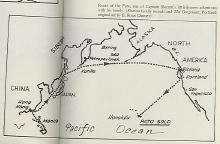 sale of the Pato in Honolulu for $5,000 in gold, the Slocums next
acquired the 350-ton Amethyst and fitted it out for the China lumber
trade. Another daughter was born, but she died soon after. In Hong
Kong, March 3, 1881, Virginia gave birth to her seventh child, James
Garfield Slocum.
Now Slocum moved up to captain and part owner of the beautiful
1,800-ton clipper, the Northern Light, one of the tallest and fastest
ships of the day.
On a bright June day in 1882, Slocum sailed her up the East River
under the new Brooklyn Bridge, her rig so tall that the upper section
had to be struck to pass under, a proud ship with a proud captain at
the pinnacle of his career. Later, there was a mutiny aboard the
Northern Light during which Virginia backed up her husband with a
loaded pistol and in which the ringleader was stabbed to death.
Continuing on to Yokohama to discharge cargo, on the return trip
the Northern Light passed the island of Krakatoa a few days before it
blew up, suffered damage off the Cape of Good Hope and lost most
of her cargo, and again endured an attempted mutiny led by an ex-
convict who came aboard at Cape Town.
The next ship was the little bark Aquidneck, which Slocum de-
scribed as the "nearest to perfection of beauty" any man could ask
for. This was operated in the South American trade and was a happy
but brief interlude in the captain's career.
On one trip to Buenos Aires, Virginia took ill suddenly, and on the
evening of July 25, 1884, she died with her husband and the children
at her bedside, not yet thirty-five years old.
sale of the Pato in Honolulu for $5,000 in gold, the Slocums next
acquired the 350-ton Amethyst and fitted it out for the China lumber
trade. Another daughter was born, but she died soon after. In Hong
Kong, March 3, 1881, Virginia gave birth to her seventh child, James
Garfield Slocum.
Now Slocum moved up to captain and part owner of the beautiful
1,800-ton clipper, the Northern Light, one of the tallest and fastest
ships of the day.
On a bright June day in 1882, Slocum sailed her up the East River
under the new Brooklyn Bridge, her rig so tall that the upper section
had to be struck to pass under, a proud ship with a proud captain at
the pinnacle of his career. Later, there was a mutiny aboard the
Northern Light during which Virginia backed up her husband with a
loaded pistol and in which the ringleader was stabbed to death.
Continuing on to Yokohama to discharge cargo, on the return trip
the Northern Light passed the island of Krakatoa a few days before it
blew up, suffered damage off the Cape of Good Hope and lost most
of her cargo, and again endured an attempted mutiny led by an ex-
convict who came aboard at Cape Town.
The next ship was the little bark Aquidneck, which Slocum de-
scribed as the "nearest to perfection of beauty" any man could ask
for. This was operated in the South American trade and was a happy
but brief interlude in the captain's career.
On one trip to Buenos Aires, Virginia took ill suddenly, and on the
evening of July 25, 1884, she died with her husband and the children
at her bedside, not yet thirty-five years old.
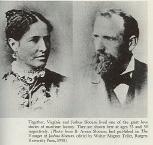 Slocum, who had lost his mother when he was sixteen, now lost the
second woman in his life when he was thirty-nine. When Virginia
died, Slocum died with her spiritually. In his grief, he ran the Aquid-
neck aground once, then two years later, with his second wife, his
cousin, twenty-four-year-old Henrietta Elliott, and two of the brood,
Victor, age fourteen, and Garfield, age five, sailed for South America
on a wedding trip. The Aquidneck was wrecked on this voyage
through a series of unfortunate incidents including a cholera epi-
demic and a mutiny during which Slocum killed two men, and
everything was lost.
~ 13 ~
Salvaging what he could from the wreckage, Slocum set about
building a 35-foot sailing dory, which he called the Liberdade,
because it was launched the day the Brazilian slaves were freed. In
this craft, with his family for a crew, Slocum sailed 5,000 miles from
Paranagua Bay to Washington, D.C., one of the most remarkable
small-boat voyages of all times.
He wrote a book about this, which he published himself and tried
to sell for $1 a copy. In the winter of 1892, his friend Captain Eben
Pierce gave him the ancient Spray, which was on the beach at Fair-
haven. Slocum, who had been five times around the world, and spent
a lifetime at sea, had little use for a yacht, but he set about rebuilding
the sloop for want of something better to do, and also as a cozy sea-
going home in which he could retreat.
He fished in the Spray one season, with little success, chartered an
occasional party, and then, in December 1893, he undertook a com-
mission to deliver the Ericsson iron-clad gunboat Destroyer to the
Brazilian government during the insurrection. After another incred-
ible voyage and masterpiece of seamanship, he was cheated out of his
pay and returned home broke again to write a book about this
hazardous voyage, which did not sell well either.
Returning to the waiting Spray, which he had recreated with his
own hands and now seemed his last refuge, he conceived the idea of a
singlehanded voyage around the world.
Although his life had crumbled around him, he still had his charts,
sextant, compass, his favorite rifles, and books, and he knew the way,
oh so well. For him, the sea was a friend, a haven, a world he under-
stood and which understood him.
He was about to discover the one thing that almost all men seek
and which few ever find in their lifetimes meaning.
And, as Slocum exclaimed to his eldest son on seeing him again,
"You could have done it, Vic--but you would not have been first!"
~ 14 ~
Slocum, who had lost his mother when he was sixteen, now lost the
second woman in his life when he was thirty-nine. When Virginia
died, Slocum died with her spiritually. In his grief, he ran the Aquid-
neck aground once, then two years later, with his second wife, his
cousin, twenty-four-year-old Henrietta Elliott, and two of the brood,
Victor, age fourteen, and Garfield, age five, sailed for South America
on a wedding trip. The Aquidneck was wrecked on this voyage
through a series of unfortunate incidents including a cholera epi-
demic and a mutiny during which Slocum killed two men, and
everything was lost.
~ 13 ~
Salvaging what he could from the wreckage, Slocum set about
building a 35-foot sailing dory, which he called the Liberdade,
because it was launched the day the Brazilian slaves were freed. In
this craft, with his family for a crew, Slocum sailed 5,000 miles from
Paranagua Bay to Washington, D.C., one of the most remarkable
small-boat voyages of all times.
He wrote a book about this, which he published himself and tried
to sell for $1 a copy. In the winter of 1892, his friend Captain Eben
Pierce gave him the ancient Spray, which was on the beach at Fair-
haven. Slocum, who had been five times around the world, and spent
a lifetime at sea, had little use for a yacht, but he set about rebuilding
the sloop for want of something better to do, and also as a cozy sea-
going home in which he could retreat.
He fished in the Spray one season, with little success, chartered an
occasional party, and then, in December 1893, he undertook a com-
mission to deliver the Ericsson iron-clad gunboat Destroyer to the
Brazilian government during the insurrection. After another incred-
ible voyage and masterpiece of seamanship, he was cheated out of his
pay and returned home broke again to write a book about this
hazardous voyage, which did not sell well either.
Returning to the waiting Spray, which he had recreated with his
own hands and now seemed his last refuge, he conceived the idea of a
singlehanded voyage around the world.
Although his life had crumbled around him, he still had his charts,
sextant, compass, his favorite rifles, and books, and he knew the way,
oh so well. For him, the sea was a friend, a haven, a world he under-
stood and which understood him.
He was about to discover the one thing that almost all men seek
and which few ever find in their lifetimes meaning.
And, as Slocum exclaimed to his eldest son on seeing him again,
"You could have done it, Vic--but you would not have been first!"
~ 14 ~
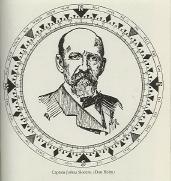
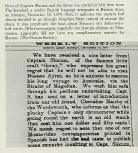
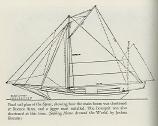
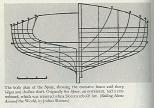 - end Chapter 1 -
- end Chapter 1 -
=======================================================================
AUTHOR'S NOTES
Chapter One
1. The Spray's dimensions were, in the words of its captain, 36 feet,
9 inches overall, 14 feet 2 inches wide, and 4 feet 2 inches deep in the hold.
Her net tonnage was 9, and her gross, 12.71 tons.
2. Robinson & Stephenson, 1897. An 1894 edition was published in
Boston by Roberts Brothers, who also acted as Slocum's literary agents during
his circumnavigation.
3. Slocum's eldest son, Victor, considered his father's dollar-and-a-half
chronometer merely one of his sly jokes. The captain, although he had no formal
education, was an expert navigator with long experience. In point of fact, a
chronometer is not absolutely necessary. Both latitude and longitude can be found
with sextant and dead reckoning, and the captain had all his instruments with him.
After forty-three days from the island of Juan Fernandez to Nuku Hiva, the
Spray was found to be exactly on course. The high and beautiful island in the
Marquesas, said Victor, was used merely to check on her longitude.
At this point, Slocum wrote: "I hope I am making it clear that I do not lay
claim to cleverness or to slavish calculations in my reckonings. I think I have
already stated that I kept my longitude, at least, mostly by intuition A rotator
log always towed astern, but so much has to be allowed for currents and for
drift, which the log never shows, that it is only an approximation."
Slocum made lunar observations for his own satisfaction, finding errors in the
tables he carried.
"The tables being corrected, I sailed on with self-reliance unshaken, and with
my tin clock fast asleep. I was en rapport with my surroundings, and was car-
ried on a vast stream where I felt the buoyancy of His hand who made all the
worlds. I realized the mathematical truth of their motions, so well known that
astronomers compile tables of their positions through the years and the days
and the minutes of the days, with such precision that one coming along over
the sea five years later, may by their aid, find the standard time of any given
meridian on earth."
4. "Looking out of the companionway," Slocum wrote, "to my
amazement I saw a tall man at the helm. His rig was that of a foreign sailor,
and the large red cap he wore was cockbilled over his left car, and all was set
off with shaggy black whiskers. 'Senor,' said he, doffing his hat, 'I have come to
do you no harm. I am one of Columbus's crew. I am the pilot of the Pinta
come to aid you. Lie quiet, Senor Captain, and I will guide your ship tonight.' "
With this little bit of whimsy, Slocum started a tradition that still delights
voyagers today. The pilot of the Pinta has become the patron saint of all solo
circumnavigators.
5. Slocum cannot even bring himself to mention Virginia in his book.
He does tell how Captain Howard, when he learned of the pilot of the Pinta,
refused to return aboard the Spray.
6. Enormous waves, the culmination of several joined together on
the long fetches of the southern oceans, have been encountered by all voyagers
in those waters, including Vito Dumas, Dwight Long, Harry Pidgeon, Alain
Gerbault, William Albert Robinson, and the Smeetons. Another phenomenon
which Slocum alluded to, but which others failed to record, was mirages and
illusions, which at times made seagulls appear as giant birds one moment and
as tiny specks the next.
7. During this storm, in which he was blown down toward the Horn
by a northwest gale, Slocum kept his ship under control and running before the
tempest by towing large warps astern He was the first to report on this tech-
nique which is now standard practice among small-boat voyagers.
8. The Keeling-Cocos Islands were discovered in 1608 by Captain
William Keeling, in the service of the East India Company, and settled by
Captain John Clunies-Ross in 1814, who brought in Malay natives to colonize
them. Later a cable station and now an airways communication link, they are
under Australian protection although still held by the Clunies-Ross family. This
is a popular landfall on the long run across the Indian Ocean, and almost every
yacht calls in here for a rest before tackling the usually boisterous ocean to
Mauritius.
9. Clark was still there when Harry Pidgeon arrived in the Islander
almost a quarter century later, and got the goat story firsthand
10. The document was later turned over to the Treasury Department
as a record of the voyage.
11. The Voyages of Joshua Slocum (New Brunswick, N.J.: Rutgers
University Press, 1958).
12. Ironically, the first copy of the Spray to attempt a circumnaviga-
tion, the Australian Pandora went missing in the same general area in 1911
after surviving a capsize and dismasting while rounding the Elorn. The Pandora
was the first to attempt the Cape Horn route, and was an almost exact copy of
the Spray.
13. Slocum was described by a reporter on the day he left Boston for
his circumnavigation as a man 5 feet 9 1/2 inches tall, weighing 146 pounds, and
"as spry as a kitten and nimble as a monkey."
As a matter of further historical interest, during World War 11,
a Liberty ship, the Joshua Slocum was launched at a Portland shipyard, in
honor of the old gent who as a youth had designed and built Columbia River
gillnet boats, and who fished and hunted in this area for some months. After
the war, the Joshua Slocum was tied up for years in the Moth Ball Fleet at
Tongue Point, near Astoria, within sight of his old fishing grounds.